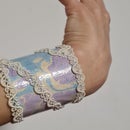Introduction: Netted Rope Lamp
I'm making this Instructable to show my entire work process when I'm creating a lamp. It is mostly for documentation purpose, but if you find it useful, all the better.
I chose as example a simple lamp to keep it short, since I will make separate Instructables for more complex circuits or designs.
I will add what materials are needed for each step when I use them.
I hope you enjoy it! :)
Step 1: Netting the Lampshade
To create an object made of netted rope you need:
- rope, obviously :)
- scissors
- glue gun
- the cat is not mandatory, but I recommend having one around =^.^=
I started developing this technique in 2013. Since then it's been present in some degree in all my work.
I cut two pieces of rope and loosen the fibres at each end. Then I wave together the ends of two different pieces as shown in this video.
Using several pieces of rope I create a net that I can shape into different objects.
For this lampshade, I use only two pieces of rope.
I wave two of their ends together and then I intertwine the middle part of the ropes however I feel like it.
It will turn out different each time depending on the inspiration and size of the pieces.
After I decide upon a structure, I wave the other two ends together.
Then I proceed to connect the two weaved parts together or with the middle parts of the ropes in order to create a compact object that says something to me aka. that looks good.
You can glue everything at the end like I did this time or every time you make a knot you also glue it.
Either way, you have to glue all the knots and the edge of the weaved parts.
After that, we can cut the extra rope from the knots and even the edges.
If you are not a fan of glue guns, you can use something else that glues rope. Before discovering the glue gun, I was using polyvinyl acetate glue.
I usually do not paint the object as I'm fond of the natural color of the rope, but this time I did.
Step 2: Painting Rope Objects
I prefer to use spray dye to paint rope objects because it is the easiest way I know to do this.
I advise you to use gloves, a mask over the mouth and nose and a plastic to cover the surface you are working on. You may be able to clean the dye afterwards, but it is not worth the effort.
I also advice being outdoors if possible, if not, keep the windows open the rest of the day.
Position yourself so that the wind will not blow towards you. As stated above, you can clean the dye, but it's not worth the effort if you can prevent getting it all over you. ;)
Just spray the paint on the object! ;)
Make sure you covered all the object - rope can be tricky. Turn the object on all sides to make sure it is covered as you want.
Keep the objects outside to dry for at least 24 hours.
Step 3: Electric Circuit With a 12V LED
Tools:
- 220V AC to 12V DC adapter
- G4 socket
- 12V LED
- 25A, 250V AC switch
- scissors
- wire stripper crimper - that I forgot to add to the first photo ^.^
- screwdriver
If you have a normal charger, like I got, you'll have to cut the jack, in order to fit the wires in the switch.
Inside the main insulation, you'll see two wires, each with their own insulation.
You'll have to cut the main insulation between the two wires.
To reduce the chance of cutting one of them, cut only a small part, enough to grab each side and pull it apart with your hands.
To measure how much you have to separate the two wires, open the switch and measure with the wire the distance from the screw terminal to the edge. Make sure not to cut the main insulation over the edge of the switch because you'll have to redo it.
Before fitting the two wires from the charger in the screw terminals you have to cut the insulation on the part that gets in. Here comes in play the wire stripper. This tool is helpful to remove insulation without risking to cut the wires too. It has indentations for each type of wire. Since these wires will be really thin, I use the smallest indentation.
The switches I use, have a thing at the edge to hold the wire down. Most switches don't have it. It's nothing special.
On the other side of the switch fits the G4 socket. After all the wires are screwed into the terminals, you can close the switch.
Put the LED in the socket and the charger in to outlet and it will light up when you turn it on.
Simple as pi. :)
Step 4: Bringing Everything Together
Now all that's left is to fit the socket (and the attached circuit) through the netted rope and tie it so that it won't move.
As far as I've noticed this socket does not heat up too much, but since we used spray dye and that's flammable, I used fire retardant varnish around the place where the socket is placed, both on the outside and the inside of the object. Better safe than sorry. :)
Place the LED in the socket and it's done. :D

Participated in the
Creative Misuse Contest











